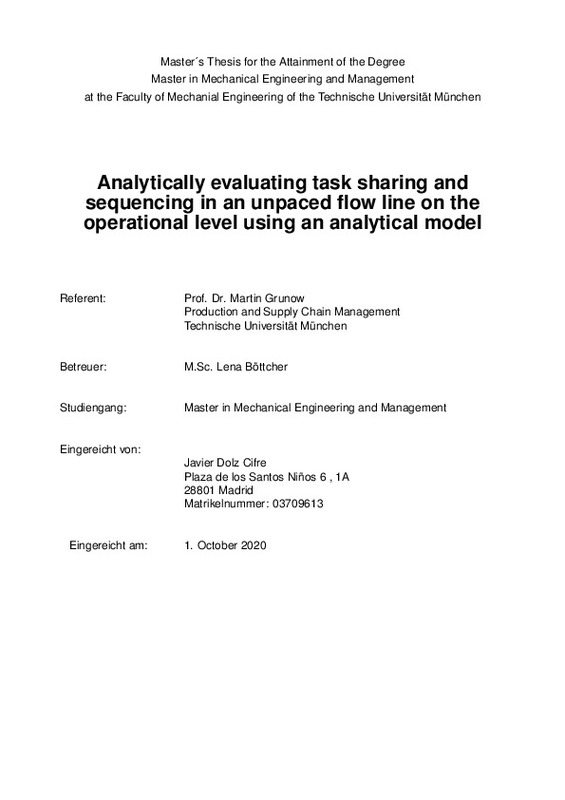|
Resumen:
|
[EN] Task sharing helps to reduce imbalances in mixed-model lines, derived from blocking and starving stations. On the other hand, intelligent sequencing also gives us the
possibility to face these waiting times and ...[+]
[EN] Task sharing helps to reduce imbalances in mixed-model lines, derived from blocking and starving stations. On the other hand, intelligent sequencing also gives us the
possibility to face these waiting times and increase the efficiency of our line. Even
though both techniques have been widely studied in the past, no attention was paid
to the interaction of both of them. This thesis focuses on the influences that task
sharing and sequencing have between each other when studying the makespan in a
mixed model assembly line.
[-]
[ES] La principal fuente de desequilibrio en las líneas de montaje con mezcla de modelos son las diferentes tareas y los diferentes tiempos de las tareas para los diferentes modelos (Bukchin et al.,1997). Además, el ...[+]
[ES] La principal fuente de desequilibrio en las líneas de montaje con mezcla de modelos son las diferentes tareas y los diferentes tiempos de las tareas para los diferentes modelos (Bukchin et al.,1997). Además, el desequilibrio puede ser causado por la variabilidad debida a los operadores o a las averías de las máquinas (Gel et al., 2002). Los resultados de las líneas de montaje desequilibradas son, por ejemplo, estaciones de hambre y bloqueo. Si se terminan las tareas en una estación mientras se realizan otras tareas en la estación de aguas abajo, la estación de arriba se bloquea, ya que no es posible pasar el producto a la de abajo. Por otro lado, cuando la estación de aguas abajo ha completado sus tareas antes de que la estación de arriba esté terminada, decimos que la estación de abajo tiene hambre (Conway et al., 1988).
La distribución de tareas proporciona una oportunidad para reducir este desequilibrio a través de la asignación de tareas compartidas entre las estaciones, individualmente para cada modelo en una secuencia. Para decidir qué tareas pueden ser compartidas, esta tesis distinguirá entre tareas fijas y compartidas. Las tareas fijas son aquellas que sólo pueden realizarse en una estación determinada, ya que requieren herramientas que sólo están disponibles en una de las estaciones. Las tareas compartibles son aquellas que pueden realizarse en más de una estación. Las tareas compartidas crean un grado de libertad en una línea de montaje que permite decidir dónde realizar una tarea para optimizar la producción en la línea de acuerdo con un objetivo determinado (por ejemplo, reducir al mínimo el tiempo de fabricación, maximizar la equidad, reducir al mínimo el coste y la complejidad operacional, etc.). Otra estrategia para reducir los tiempos de hambre y bloqueo es la implementación de buffers (Conway et al. 1988; McClain et al., 2000), que se incluyen en el sistema investigado en este trabajo.
La bibliografía existente se centra principalmente en las líneas de montaje sin buffers entre estaciones (Hudson et al., 2015), donde el impacto de los trabajadores en el ritmo de trabajo es muy restringido (Gosh et al., 1989, p.652). Este Trabajo Fin de Máster se centrará en una línea de montaje con buffers entre estaciones de trabajo consecutivas que se utiliza como una línea de montaje con mezcla de modelos, donde se producen distintos modelos de un producto en la misma línea de montaje sin cambios o ajustes en su maquinaria.
[-]
[EN] The main source of imbalance in mixed model lines is different tasks and different task times for different models (Bukchin et al.,1997). Also, imbalance can be caused by the variability due to operators or machine ...[+]
[EN] The main source of imbalance in mixed model lines is different tasks and different task times for different models (Bukchin et al.,1997). Also, imbalance can be caused by the variability due to operators or machine breakdowns (Gel et al., 2002). Results of unbalanced assembly lines are, for example, starving and blocking stations. If tasks are finished at a station while other tasks are being performed at the downstream station, the upstream station gets blocked, as it is not possible to pass the product downstream. On the other hand, when the downstream station has completed its tasks before the upstream station is finished, the downstream station starves (Conway et al., 1988).
Task sharing provides an opportunity for reducing this unbalance through the assignment of shared tasks between stations, individually for each model in a sequence. To decide which tasks can be shared, this thesis will distinguish between fixed and shareable tasks. Fixed tasks are tasks that can only be performed in a particular station, as they require tools that can only be available at one of the stations. Shareable tasks are tasks that can be performed in more than one station. Shareable tasks create a degree of freedom in an assembly line that allows to decide where to perform a task in order to optimize the production in the line according to a given objective ( for example, minimizing the makespan, maximizing fairness, minimizing cost and operational complexity, etc.). Another strategy to reduce starving and blocking times is the implementation of buffers (Conway et al. 1988; McClain et al., 2000), which are included in the system investigated in this thesis.
Existing literature mainly focuses in paced lines (Hudson et al., 2015), where the impact of the workers on the work pace is very restricted (Gosh et al., 1989, p.652). This Master¿s thesis will focus in an unpaced flow line with consecutive workstations that is used as a mixed-model line, where distinct models of a product are produced on the same assembly line without changeovers.
[-]
|







